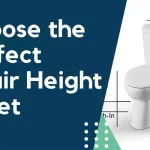When it comes to plumbing, there’s more to toilets than meets the eye. Proper toilet venting is a critical aspect of maintaining a healthy and efficient plumbing system. If you’re scratching your head over toilet venting options and wondering how to ensure everything flows smoothly, you’re in the right place. In this article, we will provide you with the best guide to vent a toilet, offering valuable insights and expert advice to help you navigate the intricacies of toilet ventilation. Whether you’re a seasoned DIY enthusiast or a novice homeowner, our comprehensive guide will equip you with the knowledge and techniques needed to tackle toilet venting with confidence.
In this detailed guide, we’ll talk about toilet venting, covering everything from the importance of venting to understanding vent distances, accommodating multiple fixtures, considering air admittance valves, and much more.
Also Read: Best Dehumidifier for Bathroom in 2023
Content
Best Guide to Vent a Toilet: Essential Tips and Techniques
Discover essential tips and techniques in the “Best Guide to Vent a Toilet” to ensure optimal plumbing efficiency and healthy home maintenance
1. The Essence of Toilet Venting
Toilet venting is all about maintaining balanced air pressure within your plumbing system. It prevents suction that can lead to slow drainage, gurgling noises, and even the release of sewer gases into your living spaces.
2. Vent Distance
The distance between a toilet and its vent is crucial. While regulations differ, a common guideline suggests that the toilet’s vent should be within 6 feet of the toilet itself. Always consult local plumbing codes to ensure compliance.
3. Harmonizing with Other Fixtures
Your toilet isn’t alone in the plumbing universe. Sinks, showers, and other fixtures need proper venting too. To optimize space and efficiency, consider shared venting systems that cater to multiple fixtures.
4. Air Admittance Valves (AAVs)
If traditional venting methods aren’t practical, AAVs come to the rescue. These valves allow air to enter the plumbing system while preventing gases from escaping. They’re especially handy when retrofitting existing plumbing.
5. Decoding Toilet Vent Requirements
While building codes often mandate individual venting for toilets, shared vents are sometimes permissible under specific conditions. Consulting local regulations and plumbing professionals is vital to ensure you’re on the right track.
Also Read: How To Replace Bathroom Fan
FAQs:
Does A Toilet Need A Vent?
Absolutely. A toilet vent is non-negotiable. Without proper venting, you’ll experience drainage issues, gurgling sounds, and even unwanted sewer odors invading your home.
How Far Can A Toilet Be From A Vent Stack?
Plumbing codes dictate that the toilet’s vent should ideally be within 6 feet of the fixture. However, distances can vary based on local regulations and specific circumstances.
In conclusion, toilet venting isn’t just a technicality; it’s a fundamental element of a well-functioning plumbing system. By grasping the essentials, understanding vent distances, accommodating other fixtures, and exploring options like air admittance valves, you’re on your way to a plumbing system that operates smoothly and odor-free.
When in doubt, seek guidance from plumbing professionals who can navigate local codes and ensure your toilet’s venting is up to par. Your plumbing system will thank you for the attention to detail, and you’ll enjoy the peace of mind that comes with a smoothly running toilet.























